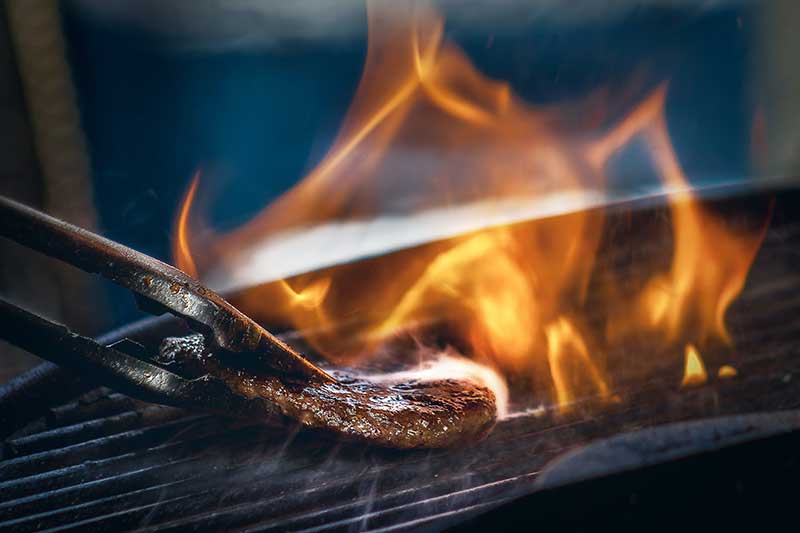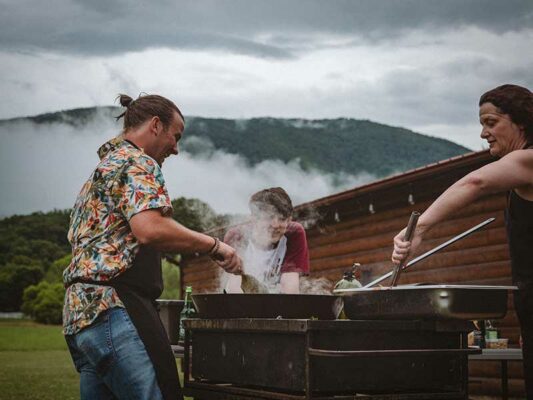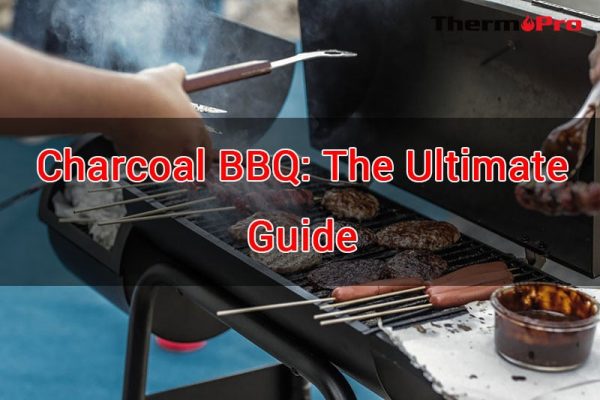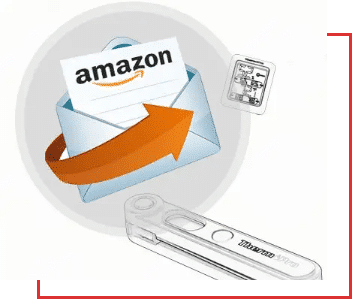The customer service team is always listening, taking notes, and quantifying complaints to ensure our products are continually improved. Due to selling directly to you, the customer, via Amazon, we can use product reviews to help us improve our existing products or help further development of new products.
Table of Contents
Nothing tastes better than food grilled on a charcoal grill. From burgers and brats to salmon and smoked brisket, charcoal is the key to making some of the best food that can be made with fire and smoke. However, one of the most common questions that charcoal users will face is how do you regulate the heat on a charcoal grill.
After all, there is not a knob to turn on charcoal like on propane. Luckily, the great taste and amazing versatility of charcoal are still within easy reach, especially if you use a digital food thermometer to make sure that that your charcoal grill temperature is ideal.
The Shortcomings for Charcoal Grill Temperature Management
Of course, charcoal is not always perfect. There are a number of shortcomings that arise when cooking with charcoal, depending on your situation. Before we go any further, it is best to have a solid understanding of what those shortcomings are and how they may impact your cooking.
Short Cooking Time
The most obvious shortcoming of charcoal over propane is that while propane grills have a continual feed of fuel (as long as you filled up the tank), charcoal tends to burn off. In many cases, once the charcoal is ashed over and ready for most users, it has perhaps only thirty minutes of actual productivity left.
While that is more than enough time to grill a few burgers, if you are looking to have the grill fired up for an afternoon, or are planning to smoke something, it will require some action to be sure that the fire does not go out.
Difficult to Achieve an Even Temperature
Even within that relatively short period of time, maintaining an even temperature can be challenging. After all, since each chunk or briquette of charcoal is producing heat, and each one of them is irregular in how it produces said heat, it is impossible to be sure that the entire grilling area is perfectly even. There are some workarounds for this, however.
First, make sure to use an adequate amount of charcoal to provide an even layer across the surface.
Second, embrace the irregularity; use of direct and indirect cooking areas will help keep the hot side warmer for longer, while still allowing you to finish meals over indirect heat.
Hard to Control Temperature
Propane grills are usually able to maintain a pretty even temperature, depending on where you put the dial.
You can vary the temperatures for direct and indirect heat, but you won’t be searing steaks and glazing fish on the same grill with charcoal. Instead of a multitasker, therefore, it is essential to think of your charcoal grill as the perfect unitasker.
It can do one thing especially well, and there are a number of things that it can indeed do. However, it is simply not capable of doing more than that.
Lack of Features
Propane grills come with a multitude of special features that you simply are not going to see on a charcoal model.
For example, a side burner, whether to sauté onions or keep a sauce warm before glazing meat, simply is not going to be possible on a charcoal model.
Additionally, while the vast majority of propane grills (except, perhaps, those at a clumsy neighbor’s house) have some sort of self-ignition feature, charcoal grills will require some other method, be it a starting stick, chimney starter, or lighter fluid.
Also, you won’t find too many rotisseries on a charcoal grill, while they are becoming increasingly common with propane models.
The Secret Key to Temperature Control on a Charcoal Grill
Luckily, there is a way around much of this. If you are looking to control the temperature of your grill and prolong cooking time, it is important to remember that fire requires two components.
The first, fuel, comes from charcoal.
The second, oxygen, comes from the air around the fire.
By controlling the flow of air, we are better able to determine how fast, and hot, the fire burns. As a general rule, the more air you let into a fire, the hotter it will become. This is the same reason that blacksmiths used bellows.
If you have the air dampers fully open, then you are likely to have a grill that reaches temperatures in excess of 550 degrees Fahrenheit. However, if you reduce the opening of the dampers by half, your fire will not decrease by half in temperature.
Instead, it will settle between 350 and 450 degrees. Similarly, if you are looking to cook something low and slow, you could close the dampers even more; a quarter of the way open will result in a temperature of around 325 degrees, while being any more than that (assuming the charcoal was already lit before entry) will produce temperatures of around 250 degrees, perfect for slow cooking or smoking.
Of course, if you close the dampers all the way and enclose the flame, it will extinguish the fire. Think of this as a way of putting out the fire without the smoke and ash of pouring water on it, but do remember to check for any lingering embers before you leave the area.

Charcoal Briquette Temperature Chart
It is not only the temperature of the charcoal in the grill that matters but also the temperature of the charcoal that you add to the fire.
One of the most common, and indeed best, ways of heating charcoal is through the use of a chimney starter.
One of the major advantages of a chimney starter is that it allows you to add coals to the fire at about the same temperature as the cooking environment, meaning that you are able to avoid temperature spikes while making sure that your fuel is as effective as possible.
Here follows a guide to knowing how much charcoal to use; best of all, it can also help you determine how much to use to initially start your fire.
If you are looking to smoke meat or grill at relatively low temperatures not in excess of 350 degrees, it is best to only fill a standard chimney starter (i.e. one that holds approximately 100 briquettes) only about 25% of the way full.
If you are looking to grill at a higher temperature of around 400 degrees, to make hot dogs for a tailgate or hamburgers for those who insist on well-done beef, then filling the chimney halfway will be most beneficial.
For those looking to make burgers at medium or rare, or steaks to well done, then filling up the chimney 75% will result in temperatures of around 500 degrees. Finally, if you are looking to sear steaks over as hot of a temperature as possible, fill the chimney completely up.
Tips to Know When the Heat is Right for Grilling with Charcoal
The most sure-fire way to test for temperature, however, is to check the temperature of the meat that you are cooking. Many standard thermometers take nearly a minute to determine the temperature. This can result in overdone meat.
However, instant-read thermometers, like those from ThermoPro, allow you to instantly find the temperature of the food in question.
Instant Read Thermometers
To use an instant-read thermometer, simply insert the probe tip into the thickest part of the meat being cooked, being sure not to hit any bones.
For many types of meat, including sausages, hamburgers, and barbecue, it is often best to check the temperature by inserting the thermometer on the side. That means you are less likely to stick the thermometer completely through the meat in question. Within seconds, the thermometer will provide an accurate temperature.
Probe Thermometers
For those who plan on cooking something that requires more time away from the charcoal, like when smoking or roasting, a probe thermometer can be beneficial. These thermometers have a wire that attaches to a probe that can be directly inserted in the meat in question.
This allows you to walk away from the food, assured in the fact that an alarm will ring when the meat has reached the target temperature. Be sure to put the display away from the grill.
No matter what kind of thermometer you use, it is generally a good idea to let your meat rest for a few minutes after cooking. This allows you to pull the meat off a few degrees shy of where it should ultimately end up, resulting in a more tender and juicy cut of meat.
Here are some choices for you:
Conclusion
With the proper preparation, using charcoal to grill or smoke can be much more enjoyable than using propane alone, and allow you to cook a much broader range of dishes.
While it may not be as straight-forward as turning a dial, figuring out “what temperature should my charcoal grill be” can be easily done through proper methods, and properly ensured by making sure to check the temperature of your food.









